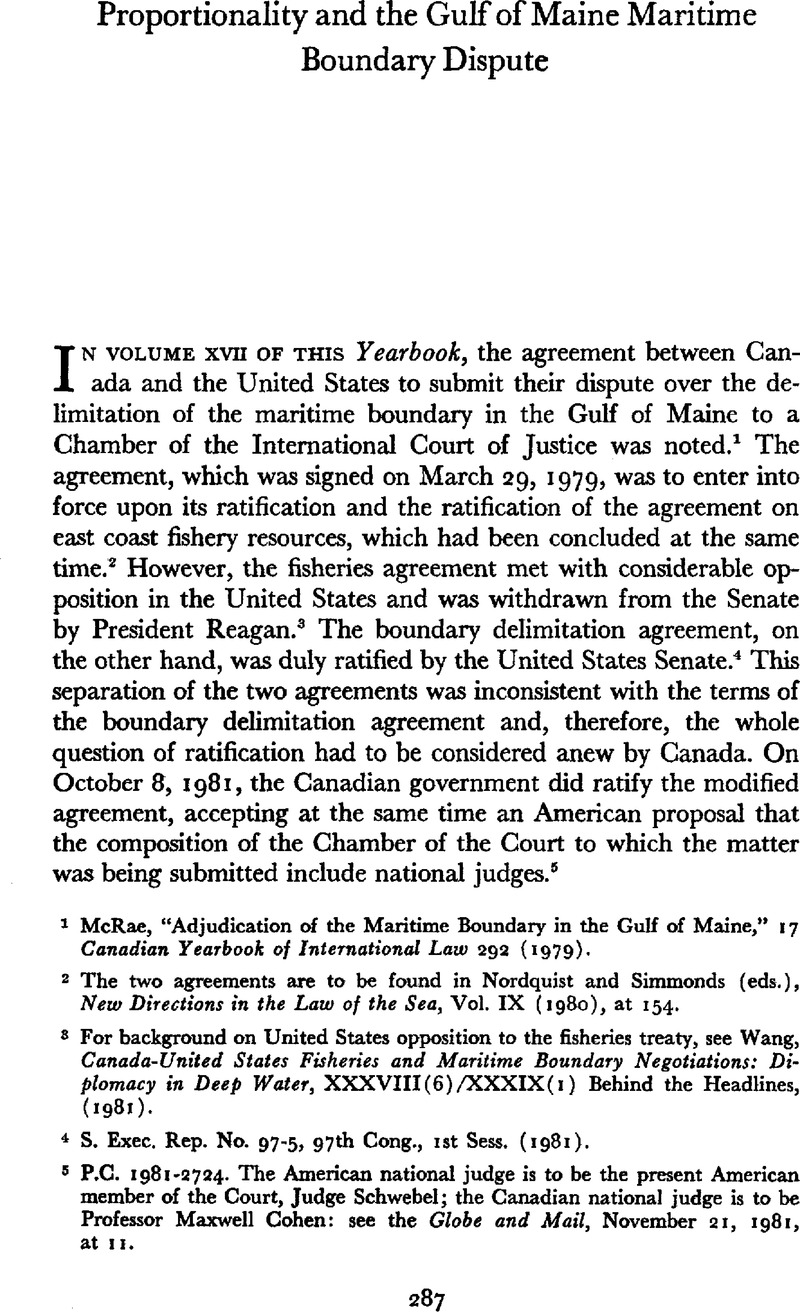Published online by Cambridge University Press: 09 March 2016

1 McRae, , “Adjudication of the Maritime Boundary in the Gulf of Maine,” 17 Canadian Yearbook of International Law 292 (1979).Google Scholar
2 The two agreements are to be found in Nordquist, and Simmonds, (eds.), New Directions in the Law of the Sea, Vol. 9 (1980), at 154.Google Scholar
3 For background on United States opposition to the fisheries treaty, see Wang, , Canada-United States Fisheries and Maritime Boundary Negotiations: Diplomacy in Deep Water, 38(6)/XXXIX(1) Behind the Headlines, (1982).Google Scholar
4 S. Exec. Rep. No. 97–5, 97th Cong., 1st Sess. (1981).
5 P.C. 1981–2724. The American national judge is to be the present American member of the Court, Judge Schwebel; the Canadian national judge is to be Professor Maxwell Cohen: see the Globe and Mail, November 21, 1981, at 11.
6 Draft Convention on the Law of the Sea, A/CONF. 62/L. 78, August 28, 1981.
7 Art. 74. Art. 83 provides an identical rule for the delimitation of continental shelf boundaries.
8 Art. 74 of the Draft Convention-Informal Text had provided :
The delimitation of the exclusive economic zone between states with opposite or adjacent coasts shall be effected by agreement in conformity with international law. Such an agreement shall be in accordance with equitable principles, employing the median or equidistance line where appropriate, and taking account of all circumstances prevailing in the area concerned.
9 See Brownlie, , Principles of Public International Law, 3d ed. (1979), 3–4.Google Scholar
10 Both states are parties to the Geneva Convention on the Continental Shelf, hence Art. 6(a) of the Convention is prima facie applicable to the dispute.
11 See Fuelner, , “Delimitation of Continental Shelf Jurisdiction between States: The Effects of Physical Irregularities in the Natural Continental Shelf,” 17 Virginia J. Int’l. L. 77, 92–95Google Scholar; Swan, , “That Gulf of Maine Dispute: Canada and the United States Delimit the Atlantic Continental Shelf,” 10 Nat. Res. L. 405, 416–21Google Scholar; Editorial, , “Boundary Delimitation in the Economic Zone: The Gulf of Maine Dispute,” 30 Maine L.R. 207 Google Scholar; see also Baxter, and Alexander, , “Opinion Concerning the Continental Shelf Boundary between the United States of America and Canada in the Gulf of Maine,” submitted to the Marine Resources Commission, State of Maine, referred to in Editorial op. cit. supra, 234.Google Scholar
12 Cmnd. 7438.
13 In the view of the Court the continental shelf in the area was characterized by its “essential geological continuity”; thus the trough in question, in that case the Hurd Deep-Hurd Fault Zone, could not be allowed to have a “material influence” upon the location of the boundary. Supra note 12, para 107.
14 “The Application of Equitable Principles to Resolve the United States-Canada Dispute over East Coast Fishery Resources,” 21 Harv. Int’l L.J. 667, 678 (1980).
15 “Equitable Solutions to the Maritime Boundary Dispute between the United States and Canada in the Gulf of Maine,” 75. Am. J. Int’l L. 590, 615 (1981).
16 Ibid., 619.
17 “Equitable Delimitation of Continental Shelf,” 73 Am. J. Int’l L. 60, 73–77 (1977).
18 “The International Law of Maritime Boundary Delimitation,” to be published in the Maine Law Review. I am grateful to Professors Collins and Rogoff for providing me with an advance copy of their paper. See also Feldman and Colson, “The Maritime Boundaries of the United States,” 75 Am. J. Int’l L. 729, 754–63.
19 [1969] I.C.J. Rep. 1.
20 North Sea Continental Shelf cases, Pleadings Vol. I, 77 (1968). Support was derived from an article by Sir Francis Vallat, who suggested that “where a bay or gulf is bounded by several states & the most equitable solution would be to divide the submarine area outside territorial waters among the contiguous states in proportion to the length of their coastlines”: “The Continental Shelf,” 23 B.Y.I.L. 333, 335–36 (1946).
21 Pleadings, supra note 20, at 219 (Denmark) and 371 (The Netherlands).
22 Ibid., 427.
23 Ibid., Vol. II, 186.
24 Ibid., 41.
25 Ibid., 132.
26 Supra note 19, at 22.
27 Ibid.
28 Ibid., 31.
29 Ibid., 52.
30 Ibid., 54.
31 Ibid., 50.
32 Writing shortly after the decision in the North Sea Continental Shelf cases, D. H. N. Johnson pointed out that the Court in fact seemed to support the coastal front view: “The North Sea Continental Shelf Cases,” 3 Int. Rel. 522, 529 (1969).
33 Supra note 19, at 41.
34 “The North Sea Continental Shelf Cases,” 23 C.L.P. 187, 199 (1970). See also The Legal Regime of Hydrospace 50 (1971).
35 Supra note 12, para. 99.
36 Ibid., para. 100.
37 Ibid., para. 101.
38 Ibid., paras. 195 and 244.
39 Ibid., para. 100.
40 Ibid., para, 101.
41 Bowett, , “The Arbitration between the United Kingdom and France Concerning the Continental Shelf Boundary in the English Channel and South-Western Approaches,” 49 B.Y.I.L. 1, 17 (1978).Google Scholar
42 Blecher, op. cit. supra note 17, at 73–77.
43 Blecher concludes that the Anglo-French tribunal’s rejection of “proportionality as a general principle & should be narrowly construed” (ibid.). He considers that proportionality “is an equitable principle” (author’s italics).
44 Supra note 19, at 52.
45 Rhee, op. cit. supra note 15, at 615.
46 Supra, text at note 40.
47 See Charney, , “The Delimitation of Lateral Seaward Boundaries between States in a Domestic Context,” 75 Am. J. Int’l L. 28 (1982).CrossRefGoogle Scholar
48 Quoted in Charney op. cit supra note 47, at 56.
48 This argument is pursued by Baxter and Alexander, op. cit. supra note 11.
50 Dr. Rhee cites the 1974 continental shelf boundary agreement between France and Spain in support of the proportionality principle, supra note 15, at 619–20. However, an isolated instance of state practice of this nature shows only that the parties agreed to take proportionality into account. It does not show that they considered themselves legally obliged to do so.